Evaluating Substance Use via Wastewater Analysis: An Overview of Analytical Workflows
Special Issues
Wastewater analysis has become an established approach for retrieving additional epidemiological information about the use of illicit drugs, alcohol, and tobacco at the population level. Here, we present an overview of the recent analytical frameworks and workflows for target and suspect analyses using low- and high-resolution mass spectrometry and discuss the latest advances in wastewater-based epidemiology (WBE).
Recently, wastewater analysis, also known as wastewater-based epidemiology (WBE), has become an established approach for retrieving additional epidemiological information for evaluating the use of illicit drugs, alcohol, and tobacco at the population level. WBE relies on the analysis of human metabolites (biomarkers) in urban wastewater to monitor and back-estimate substance use in the studied populations. Biomarkers of interest are typically identified and quantified with target analytical methods using liquid chromatography coupled to tandem mass spectrometry (LC–MS/MS). However, high-resolution and accurate mass spectrometry are also used in WBE to perform suspect and nontarget screening for emerging substances, such as new psychoactive substances and their metabolites, in wastewater and public urinals. This article presents an overview of the recent analytical frameworks and workflows for target and suspect analyses using low- and high-resolution mass spectrometry and discusses the latest advances in WBE. Finally, it briefly discusses future perspectives and developments.
Consumption of illicit drugs is a global health issue that affects millions worldwide, with figures suggesting that as many as 29.5 million people are affected by drug-related disorders (1). Thus, there is an urgent need to implement fast, objective, and evidence-based monitoring tools to better measure the extent of the phenomenon and assess the effectiveness of related drug policies (2). Commonly, illicit drug monitoring makes use of various indicators (for example, general population surveys, treatment demands, police statistics, and medical records) to estimate the prevalence of drug use. Yet these indicators suffer from various limitations that prevent obtaining a complete picture of the situation. In particular, these indicators do not provide an estimate of the actual amounts of illicit drugs that are being consumed, nor do they easily estimate the contribution of heavy drug users. In an attempt to overcome these limitations, an approach referred to as wastewater-based epidemiology (WBE) has been developed and implemented in the last decade (3). The WBE approach relies on the measurement of human metabolites of illicit drugs in wastewater samples collected at the influent of wastewater treatment plants (WWTP). As with urine testing, types and levels of metabolites found in wastewater reflect the type and amount of illicit drugs consumed by the sampled community. Since its first application, WBE has seen an astonishing development, both in terms of the extent of locations monitored (4) and the analytical technologies implemented (5).
Conventional illicit drugs, such as cocaine, amphetamine-type stimulants (ATS, such as amphetamine, methamphetamine, 3,4-methylenedioxymethamphetamine [MDMA]), heroin, cannabis, and their urinary metabolites have been monitored in multiple locations across the world. Beyond conventional drugs, novel psychoactive substances (NPSs), such as synthetic cathinones and phenethylamines, have also been the target of various studies (6,7). NPSs represent an ever-growing group of substances designed to mimic the effect of conventional drugs such as MDMA or cannabis (8). However, because their structure differs from that of controlled substances, they can be sold legally (mainly online) until they are detected and added to the list of scheduled chemicals. Currently, almost 700 NPSs are being monitored, yet their number has been increasing in recent years (9) and measuring the prevalence of use of these compounds is extremely difficult. This measurement is difficult mainly because new substances are being continuously introduced and users, upon which many of the monitoring systems rely (such as, household surveys), rarely know which substance they have been actually consuming. Two additional groups of substances have also been the target of WBE studies, namely pharmaceuticals with potential for abuse (for example, benzodiazepines) and opiates (such as morphine, methadone, oxycodone, and fentanyl) (10–12).
However, wastewater is a complex matrix containing thousands of compounds derived from human metabolism, personal care products, household appliances, industrial processes, and environmental runoff (such as agriculture). Furthermore, while some analytes can be measured in the high nanogram-per-liter (ng/L) or even microgram-per-liter (µg/L) range (that is, benzoylecgonine and methamphetamine), and can thus be analyzed by direct injection, others are present in much lower concentrations and require laborious sample preparation strategies (for example, opiates and NPSs). Such analyses require the use of highly sensitive and selective methods. Moreover, because of the large number of target compounds, methods are needed that allow the robust, accurate, and simultaneous analysis of multiple compounds. This article aims at providing an overview of sample preparation and instrumental techniques used in the field of WBE to process and analyze wastewater samples (Figure 1).
Figure 1: Scheme of the procedures used to analyze metabolites of illicit drugs in WBE.
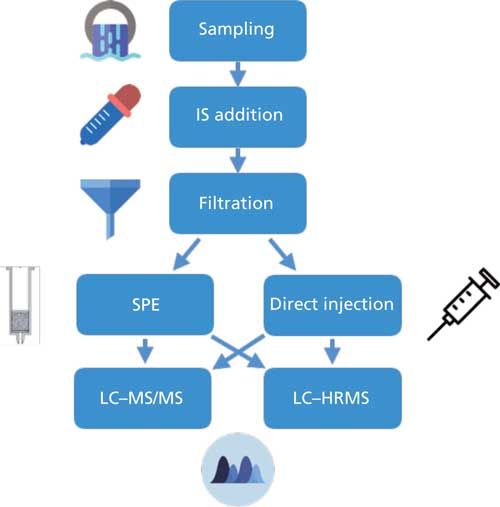
Sample Preparation
Sampling
Wastewater sampling plays a crucial role in WBE because it directly influences the representativeness of the collected samples and, consequently, the validity of the obtained estimates of illicit drug use (13). Sampling is generally carried out using automated samplers installed at the influent of a WWTP. These can be programmed to collect wastewater at fixed intervals (that is, time-proportional sampling) or as a function of the flow or volume of wastewater (that is, flow- or volume-proportional sampling, respectively) (14). Incorrect sampling approaches can have a significant influence on the total uncertainty of WBE and, even when working in ideal conditions (that is, flow-proportional sampling [14]), errors in the final estimate ranging from 5% to 10% can be expected (15).
Sample Preparation
After collection, samples are generally immediately frozen to ensure the stability of the analytes during storing and transport. After samples are received in the laboratory, they are thawed, spiked with mass-labeled internal standards, and then filtered (for example, using glass microfiber filters with a 1.6-µm pore size) (16) or centrifuged (17), because wastewater contains large amounts of suspended matter (18). The latter is generally not analyzed in WBE because of logistic reasons (that is, long sample preparation procedures involving filtration, drying, homogenization, and multiple cycles of pressurized liquid extraction [19]) and because sorption is expected to be limited due to the polarity of the target analytes. Yet, for more-lipophilic compounds, adsorption onto particulate matter has been shown to be substantial. For instance, in the case of methadone and its major metabolite 2-ethylidene-1,5-dimethyl-3,3-diphenyl-pyrrolidine (EDDP), 11–20% and 21–50% of the total concentration found in wastewater is adsorbed onto suspended matter, respectively (20).
Following filtration of wastewater samples, two approaches are most commonly implemented, namely direct injection or offline solid-phase extraction (SPE). In the first case, no further processing of the samples is applied and these are directly analyzed using liquid chromatography coupled to tandem mass spectrometry (LC–MS/MS) or high-resolution mass spectrometry (LC–HRMS) (21). Large-volume injection, with injected sample volumes of 1800 µL, has also been reported (22).
However, since some compounds, such as synthetic opiates (for example, fentanyl and substitutes) and NPSs, are present in particularly low concentrations, a preconcentration step is necessary. SPE has been carried out mainly offline, using sample volumes ranging from 10 mL to 500 mL, although successful analysis of illicit drug metabolites in wastewater using online SPE and sample volumes of only 5 mL has been reported (23). Various types of sorbents have been contemplated, as shown in Table I, yet because most illicit drugs are weak bases, ion-exchange and, in particular, mixed reversed-phase cation-exchange sorbents have been most commonly used (24). Reversed-phase sorbents have also been contemplated, in particular because these provide improved recovery for 11-nor-9-carboxy-delta-9-tetrahydrocannabinol (THC-COOH), one of the metabolites of the active ingredient in cannabis, tetrahydrocannabinol (THC) (Table I). Furthermore, because these sorbents are universal (25), they are generally preferred for suspect and nontargeted screening approaches (6). The use of molecularly imprinted polymers (MIPs) has also been reported, yet applications were limited to ATS (26). The authors nevertheless reported excellent results in terms of recovery, matrix effects, accuracy, and precision.
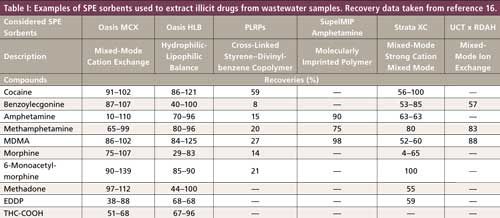
CLICK TABLE TO ENLARGE
SPE and direct injection have been commonly used in combination with LC–MS/MS, since the main objective is to obtain optimum conditions in terms of recovery and matrix effect, thus providing the highest sensitivity for a selected number of compounds. In the specific case of (targeted or unknown) screening approaches, however, sample preparation plays a crucial role. Particularly because the use of more selective preconcentration protocols based on cation-exchange SPE sorbents will limit the universality of the screening approaches, while some analytes could potentially not be detected via direct injection because of their low concentrations. In this situation, researchers have often opted for universal reversed-phase sorbents (6), which allow the recovery of a broader range of chemicals.
Chromatographic Approaches
LC–MS has by far been the most common instrumental technique used to detect and quantify illicit drug residues in wastewater. High performance liquid chromatography (HPLC) and ultrahigh-pressure liquid chromatography (UHPLC) equipped with reversed-phase chromatographic columns have been generally used. Water, ammonium formate, or acetate (1–50 mM) acidified with formic or acetic acid (0.05–0.1%) have commonly been used as aqueous phases, while methanol or acetonitrile have been used as organic phases (24). Some applications using hydrophilic interaction chromatography (HILIC) have also been reported (27,28), which provided better retention for more polar compounds, such as ecgonine methyl ester (a metabolite of cocaine), which is poorly retained on reversed-phase columns. Enantiomeric analysis has also been reported in the field of WBE (29). In particular, authors contemplated the possibility of using chiral columns, operated under isocratic conditions and using different modifiers (for example, 10% propanol and 1 mM ammonium acetate), to separate and quantify the enantiomeric fractions of various classes of illicit drugs and pharmaceuticals (30–32). These studies discerned consumption from the direct disposal of unused drugs-for MDMA in particular, which is preferentially excreted as R-enantiomer while it is synthesized as racemate (32)-and obtain clues about their potency and synthesis route (31).
Mass Spectrometry
MS/MS
MS/MS has by far been the most common mass analyzer implemented in WBE studies, in particular, because of its higher sensitivity compared to high-resolution approaches. Specifically, triple-quadrupole (QqQ) and quadrupole-linear ion trap (QLIT) mass spectrometers have been used to analyze illicit drug residues in wastewater. These were generally operated in multiple reaction monitoring (MRM, Figure 2), providing both sensitivity and selectivity through the monitoring of at least two specific transitions. Electrospray ionization (ESI), operated both in positive and negative modes, was used for the ionization of illicit drugs in WBE applications; other techniques such as atmospheric pressure chemical ionization (APCI) have not been contemplated. LC–MS/MS has been commonly used to monitor consumption of conventional drugs (for example, cocaine, ATS, heroin, cannabis), but also for more recent NPSs such as synthetic cathinones and phenethylamines (7,33,34). Examples of common limits of quantification (LOQ) are reported in Table II.
Figure 2: Scheme of workflows commonly implemented in target analysis, suspect and nontarget screening approaches for WBE applications.
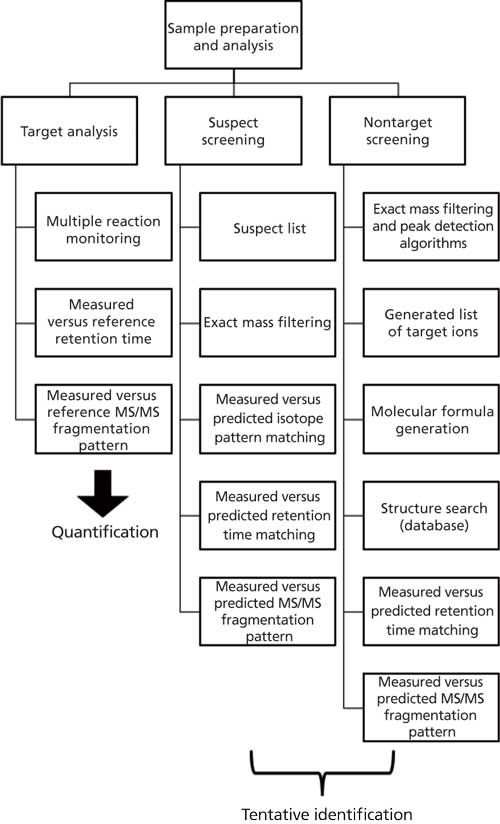
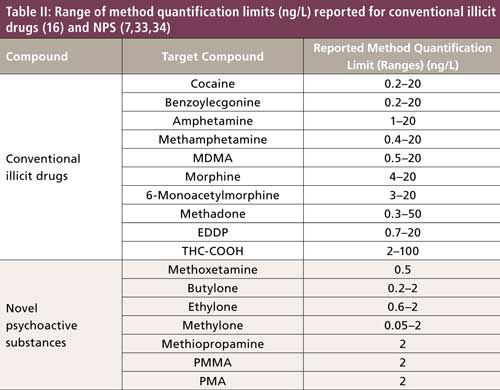
High-Resolution Mass Spectrometry
However, the implementation of LC–MS/MS is limited by the availability of certified reference standards, which, in the particular case of NPSs, are rarely available. In fact, the ever-growing number of NPSs detected makes it impossible for manufacturers and laboratories to have reference standards of the newest compounds available.
Thus, high-resolution mass spectrometry is an extremely appealing approach to tentatively screen for these compounds in wastewater and therefore detect and highlight their potential consumption. In fact, the possibility of acquiring accurate mass full spectra opens the way for conducting screening studies to detect illicit drugs, in particular NPSs, their metabolites, and transformation products as well as to elucidate unknowns (5). Furthermore, the possibility of performing retrospective analyses can determine if specific chemicals were present in previously analyzed samples, opening the way to conduct longitudinal studies. Specific workflows based on mass filtering and peak detection algorithms, molecular formula determination, isotope pattern matching, database comparison, retention time prediction, and MS/MS fragmentation pattern matching have been developed and implemented for suspect and nontarget screening approaches in the field of WBE (35,36) (Figure 2). In particular, quadrupole time-of-flight mass spectrometry (QTOF-MS) and linear ion trap orbital ion trap mass spectrometers have been implemented in WBE studies (5). The main advantage of these instruments lies in the possibility of conducting MS/MS experiments for data on product-ion spectra. The obtained data is highly useful during the tentative identification process, in particular for structure elucidation. Although MS/MS experiments can be carried out in data-dependent acquisition (DDA) and data-independent acquisition (DIA) modes, the former was generally preferred in WBE studies (6,37,38) because it reduces the load of data needing to be processed. Yet, it also increases the risk of missing relevant compounds that fall beneath the selected thresholds. However, regardless of the selected acquisition mode, methods need to undergo qualitative validation and, in particular, need to be tested on their ability to detect target compounds at the established concentrations.
Screening for New Psychoactive Substances in Wastewater
Detecting and identifying trace level compounds in a complex matrix such as wastewater has been shown to be a nontrivial task. This is particularly important for NPSs, whose lifetime on the market is relatively short (ranging from a few months to 1–2 years from introduction into the market until they are detected and banned). Individual substances will thus have a limited number of users and concentrations in wastewater will consequently be extremely low, further complicating the task of analysts trying to detect, identify, and inform public health officials about the consumption of specific NPSs. Recently, researchers active in the field of WBE have contemplated an alternative matrix to gain information about consumption of NPSs, namely pooled urine samples collected from urinals (disposed in public spaces or at festivals). The main advantage of this matrix, compared to wastewater, is that target compounds are expected to be present in substantially higher concentrations. In one study, the authors optimized both sample preparation protocols and instrumental conditions for various groups of substances (that is, general and basic drugs, as well as synthetic cannabinoids screening) (39). The analysis was carried out using a linear ion trap orbital ion trap system and, in addition to full scan MS, MS/MS, and MSn experiments, it tentatively identified 13 different NPSs in samples collected over the course of 6 months. Among these were methiopropamine, 1,4-trifluoromethylphenylpiperazine, 4-methyl-buphedrone, methcathinone, ethyl-methcathinone, and 1,4-methoxyphenylpiperazine. Following a similar strategy, researchers also implemented a suspect screening approach, involving an in-house database containing approximately 2000 entries, to identify NPSs in wastewater samples collected during a major public event (6). The authors reported the (tentative) identification of eight NPSs, ranging from identification level 1 to 3 on the scale proposed by Schymanski and colleagues (40). LC–HRMS has also been used to elucidate transformation products of NPSs in wastewater. In particular, the use of a hybrid quadrupole-orbital ion trap system to identify microbial transformation products of methylenedioxy-pyrovalerone (MDPV) has been reported (41). Through the interpretation of HR-MS2 spectra the authors were able to tentatively identify 12 transformation products as well as their biotransformation pathways (that is, demethylation followed by O-methylation, hydroxylation followed by oxidation or methylation, N-demethylation, and hydroxylation).
Perspectives
Although most applications of WBE focused on obtaining information about the consumption of illicit drugs, the potential information contained in wastewater is not limited to these substances. Recent studies have explored other applications of WBE that encompass various aspects related to lifestyle. For instance, the analysis of nicotine and its metabolites (42,43) as well as other tobacco alkaloids (that is, anatabine and anabasine) (44) in wastewater to monitor the use of tobacco has been reported by various groups. Sample preparation protocols similar to those for illicit drugs, namely SPE using mixed-mode cation-exchange sorbents (43,44) or direct injection (42), were developed and analyses were carried out using LC–MS/MS systems. A comprehensive method was recently developed to analyze a broad range of tobacco-related compounds, including nicotine metabolites, alkaloids, toxicants, and carcinogens (that is, N-nitrosoanabasine, N-nitrosoanatabine, 4-[methyl-nitrosamino]-1-[3-pyridyl]-1-butanone [NNK], and N-nitrosonornicotine [NNN]) and their metabolites (4-[methyl-nitrosamino]-1-[3-pyridyl]-1-butanol [NNAL]), for epidemiological purposes (45). The authors optimized the extraction protocol after testing various types of sorbents including mixed-mode reversed-phase cation and anion exchangers, hydrophilic-lipophilic balanced sorbents, and MIPs. The best results were obtained with mixed-mode cation-exchange cartridges.
The consumption of alcohol has also recently been monitored through wastewater analysis. This monitoring is achieved through the analysis of phase-II metabolites of ethanol, namely ethyl sulfate (EtS) and ethyl glucuronide (EtG). Analyses were performed by direct injection; however, because of the low retention of EtS and EtG on reversed-phase columns, various ion-pairing agents have been used. In one case, the authors added dihexylammonium acetate (7 mM) to the mobile phases (that is, water and methanol) (46), while in another study 50 mM tetrabutylamonium bromide were added directly to the sample (47). In one study, however, the authors reported the use of a reversed-phase column with 0.1% acetic acid in water and acetonitrile as mobile phases, without any particular sample preparation (48).
Pharmaceuticals with a potential for recreational use or abuse (for example, oxycodone, fentanyl, ketamine, and benzodiazepines) have also been the target of various WBE studies (49–51). Protocols using reversed-phase SPE cartridges and LC–MS/MS or LC–HRMS were developed and levels ranging from less than LOQ (that is, diazepam [49]) to 2.4 µg/L (that is, tramadol [50]) have been measured, highlighting the widespread use of some substances. The analysis of phosphodiesterase type V inhibitors (that is, sildenafil, vardenafil, and tadalafil) in wastewater and sludge has also been reported (52). Authors developed a method based on SPE (that is, reversed-phase hydrophilic-lipophilic balance) and pressurized liquid extraction (for sludge samples) followed by LC–MS/MS analysis. Recoveries ranged from 45% to 103%, and measured levels were 10–50 ng/L and 3–10 ng/g in wastewater and sludge, respectively. Following the results of this study, another group used measured levels of sildenafil and its metabolites in wastewater to assess the extent of illicit consumption of erectile dysfunction medications in The Netherlands (53).
Another field in which WBE has recently been implemented is the monitoring of human health, in particular through the measurement of (endogenous) biomarkers of effect or disease and biomarkers of exposure (54,55). Regarding the first group of biomarkers, the development of a method to measure oxidative stress biomarker 8-iso-prostaglandin F2alpha (8-iso-PGF2α) was recently reported (56). Instead of conventional sample preparation using SPE, the authors used an immunoaffinity cleanup step. Although recoveries were lower compared to conventional SPE sorbents (that is, anion-exchange and reversed-phase sorbents), almost no matrix effects were observed. Analyses were carried by LC–QTOF-MS and method quantification limits of 0.3 ng/L were reported.
References
- United Nations Office on Drugs and Crime, World Drug Report 2017 (Vienna, 2017), https://www.unodc.org/wdr2017/field/Booklet_4_ATSNPS.pdf.
- R. Muggah, K. Aguirre, and I. Szabo de Carvalho, Measurement Matters: Designing New Metrics for a Drug Policy that Works (Instituto Igarapé, 2015).
- S. Castiglioni, R. Bagnati, D. Calamari, R. Fanelli, and E. Zuccato, J. Chromatogr. A1092, 206–215 (2005).
- C. Ort et al., Addiction109(8), 1338–1352 (2014).
- F. Hernández et al., Mass Spectrom. Rev. (2016). doi:10.1002/mas.21525.
- A. Causanilles et al., Chemosphere (2017). doi:10.1016/j.chemosphere.2017.06.101.
- J. Kinyua et al., Drug Test. Anal.7(9), 812–818 (2015).
- D.K. Tracy, D.M. Wood, and D. Baumeister, BMJ, i6848 (2017). doi:10.1136/bmj.i6848.
- EMCDDA and Europol, EMCDDA - Europol 2016 Annual Report on the implementation of Council Decision 2005/387/JHA (2017), http://data.consilium.europa.eu/doc/document/ST-10506-2017-INIT/en/pdf.
- F. Been et al., Drug Alcohol Depend.151, 203–210 (2015).
- M.R. Boleda, M.T. Galceran, and F. Ventura, J. Chromatogr. A1175, 38–48 (2007).
- B.J. Tscharke, C. Chen, J.P. Gerber, and J.M. White, Sci. Total Environ.565, 384–391 (2016).
- C. Ort, M.G. Lawrence, J. Rieckermann, and A. Joss, Environ. Sci. Technol.44, 6024–6035 (2010).
- C. Ort, M.G. Lawrence, J. Reungoat, and J.F. Mueller, Environ. Sci. Technol.44, 6289–6296 (2010).
- S. Castiglioni et al., Environ. Sci. Technol. 47, 1452–1460 (2013).
- D.R. Baker and B. Kasprzyk-Hordern, J. Chromatogr. A1218(44), 8036–8059 (2011).
- L. Bijlsma, J.V. Sancho, E. Pitarch, M. Ibánez, and F. Hernández, J. Chromatogr. A1216, 3078–3089 (2009).
- C. Chen, C. Kostakis, R.J. Irvine, P.D. Felgate, and J.M. White, Drug Test. Anal. 5(8), 716–721 (2013).
- D.R. Baker and B. Kasprzyk-Hordern, J. Chromatogr. A1218(44), 7901–7913 (2011).
- D.R. Baker, V. OÄenášková, M. Kvicalova, and B. Kasprzyk-Hordern, Environ. Int.48, 28–38 (2012).
- J.D. Berset, R. Brenneisen, and C. Mathieu, Chemosphere 81, 859–866 (2010).
- A.C. Chiaia, C. Banta-Green, and J. Field, Environ. Sci. Technol.42, 8841–8848 (2008).
- C. Postigo, M.J. Lopez De Alda, and D. Barcel, Anal. Chem. 80, 3123–3134 (2008).
- A.L.N. van Nuijs et al., Sci. Total Environ. 409, 3564–3577 (2011).
- L. Bijlsma, E. Beltrán, C. Boix, J.V. Sancho, and F. Hernández, Anal. Bioanal. Chem. 406(17), 4261–4272 (2014).
- I. González-Mariño et al., J. Chromatogr. A1216, 8435–8441 (2009).
- A.L.N. Van Nuijs et al., Anal. Bioanal. Chem.395, 819–828 (2009).
- A. Gheorghe et al., Anal. Bioanal. Chem. 391, 1309–1319 (2008).
- B. Petrie, D. Camacho-Muñoz, E. Castrignanò, S. Evans, and B. Kasprzyk-Hordern, LCGC Europe28(3), 151–160 (2015).
- B. Kasprzyk-Hordern, V.V.R. Kondakal, and D.R. Baker, J. Chromatogr. A1217, 4575–4586 (2010).
- E. Castrignanò, A. Lubben, and B. Kasprzyk-Hordern, J. Chromatogr. A (2016). doi:10.1016/j.chroma.2016.02.015.
- E. Emke, S. Evans, B. Kasprzyk-Hordern, and P. de Voogt, Sci. Total Environ. doi:10.1016/j.scitotenv.2013.11.043.
- R. Bade et al., Chemosphere 168, 1032–1041 (2017).
- I. González-Mariño et al., Environ. Sci. Technol.50(18), 10089–10096 (2016).
- F. Hernández, M. Ibáñez, R. Bade, L. Bijlsma, and J.V. Sancho, TrAC Trends Anal. Chem.63, 140–157 (2014).
- R. Bade, L. Bijlsma, J.V. Sancho, and F. Hernández, Talanta (2015). doi:10.1016/j.talanta.2015.02.055.
- R. Bade, N.I. Rousis, L. Bijlsma, E. Gracia-Lor, S. Castiglioni, J.V. Sancho, and F. Hernandez, Anal. Bioanal. Chem.407, 8979–8988 (2015).
- L. Bijlsma, E. Emke, F. Hernández, and P. de Voogt, Anal. Chim. Acta768, 102–110 (2013).
- J.R.H. Archer, P.I. Dargan, H.M. D. Lee, S. Hudson, and D.M. Wood, Clin. Toxicol. 52(3), 160–165 (2014).
- E.L. Schymanski et al., Environ. Sci. Technol.48(4), 2097–2098 (2014).
- M. Mardal and M.R. Meyer, Sci. Total Environ.493, 588–595 (2014).
- T. Rodríguez-Álvarez, R. Rodil, M. Rico, R. Cela, and J.B. Quintana, Anal. Chem. 86(20), 10274–10281 (2014).
- S. Castiglioni, I. Senta, A. Borsotti, E. Davoli, and E. Zuccato, Tob. Control24(1), 38–42 (2015).
- B.J. Tscharke, J.M. White, and J.P. Gerber, Drug Test. Anal.8(7), 702–707 (2015).
- F.Y. Lai, F. Been, A. Covaci, and A.L.N. Van Nuijs, Anal. Chem. 89(17), 9268–9278 (2017).
- M.J. Reid, K.H. Langford, J. Mørland, and K.V. Thomas, Alcohol. Clin. Exp. Res.35, 1593–1599 (2011).
- T. Rodríguez-Álvarez, R. Rodil, R. Cela, and J.B. Quintana, J. Chromatogr. A1328, 35–42 (2014).
- T. Boogaerts, A. Covaci, J. Kinyua, H. Neels, and A.L.N. van Nuijs, Drug Alcohol Depend.160, 170–176 (2016).
- D. Hummel, D. Laffler, G. Fink, and T.A. Ternes, Environ. Sci. Technol.40, 7321–7328 (2006).
- T. Mackuľak et al., Forensic Sci. Int. (2016). doi:10.1016/j.forsciint.2016.08.016.
- M. Huerta-Fontela, M.T. Galceran, J. Martin-Alonso, and F. Ventura, Sci. Total Environ.397, 31–40 (2008).
- A. Nieto et al., Water Res.44(5), 1607–1615 (2010).
- B.J. Venhuis, P. de Voogt, E. Emke, A. Causanilles, and P.H.J. Keizers, BMJ349(jul01 9), g4317–g4317 (2014).
- Z. Yang, B. Kasprzyk-Hordern, C.G. Frost, P. Estrela, and K.V. Thomas, Environ. Sci. Technol.49(10), 5845–5846 (2015).
- K.V. Thomas and M.J. Reid, Environ. Sci. Technol.45, 7611–7612 (2011).
- Y. Ryu, M.J. Reid, and K.V. Thomas, J. Chromatogr. A 1409, 146–151 (2015).
Frederic Been, Foon Yin Lai, Adrian Covaci, and Alexander L.N. van Nuijs are with the Toxicological Centre at the University of Antwerp in Antwerp, Belgium. Direct correspondence to: adrian.covaci@uantwerpen.be
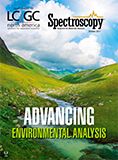
Advances in Non-Targeted Analysis for PFAS in Environmental Matrices
March 27th 2025David Megson from Manchester Metropolitan University in Manchester, UK, spoke to LCGC International about the latest developments in non-targeted analysis (NTA) of per- and polyfluoroalkyl substances (PFAS) in environmental matrices based on a recent systematic review paper he has collaboratively published (1).
Study Explores Thin-Film Extraction of Biogenic Amines via HPLC-MS/MS
March 27th 2025Scientists from Tabriz University and the University of Tabriz explored cellulose acetate-UiO-66-COOH as an affordable coating sorbent for thin film extraction of biogenic amines from cheese and alcohol-free beverages using HPLC-MS/MS.
Quantifying Microplastics in Meconium Samples Using Pyrolysis–GC-MS
March 26th 2025Using pyrolysis-gas chromatography and mass spectrometry, scientists from Fudan University and the Putuo District Center for Disease Control and Prevention detected and quantified microplastics in newborn stool samples.











